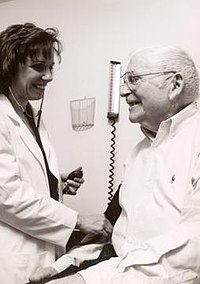
Photo from wikipedia
This study aimed to estimate the diagnostic performance of patient symptoms and to describe the clinical course of RT-PCR-positive compared with RT-PCR-negative patients in primary care. Symptomatic COVID-19 suspects were… Click to show full abstract
This study aimed to estimate the diagnostic performance of patient symptoms and to describe the clinical course of RT-PCR-positive compared with RT-PCR-negative patients in primary care. Symptomatic COVID-19 suspects were assessed clinically at the initial consultation in primary care between March and May 2020, followed by phone consultations over a span of at least 28 days. Sensitivity and specificity were estimated for each symptom using the initial RT-PCR result as a reference standard. The proportions of symptomatic patients according to the RT-PCR test results were compared over time, and time to recovery was estimated. Out of 883 patients, 13.9% had a positive RT-PCR test, and 17.4% were not tested. Most sensitive symptoms were cough, myalgia, and a history of fever, while most specific symptoms were fever for ≥4 days, hypo/anosmia, and hypo/ageusia. At the final follow up (median time 55 days, range 28–105 days), 44.7% of patients still reported symptoms in the RT-PCR-positive group, compared with 18.3% in the negative group (p < 0.001), mostly with hypo/anosmia (16.3%), dyspnea (12.2%), and fatigue (10.6%). The discriminative value of individual symptoms for diagnosing COVID-19 was limited. Almost half of the SARS-CoV-2-positive patients still reported symptoms at least 28 days after the initial consultation.
Journal Title: Infectious Disease Reports
Year Published: 2023
Link to full text (if available)
Share on Social Media: Sign Up to like & get
recommendations!